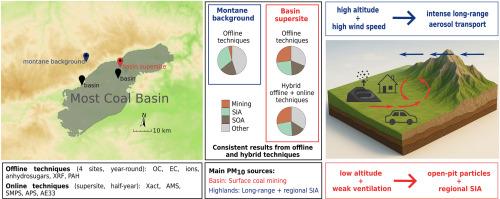Multi-site vs. supersite aerosol source apportionment in a lignite basin area
IF 7.3
2区 环境科学与生态学
Q1 ENVIRONMENTAL SCIENCES
引用次数: 0
Abstract
Section snippets
Measurement sites
The research area was the northwest part of the Czech Republic. The North Bohemian lignite basin is part of the so-called ‘Black Triangle’, located at the tri-border of the Czech Republic, Poland, and Germany. The exploitation of coal and its use for industrial heat and power generation, as well as household heating, has led to worsened air quality here, especially in terms of concentrations of particulate matter and polycyclic aromatic hydrocarbons (PAH) (Hůnová, 2020).Four monitoring sites (Results and discussion
The annual average PM10 concentrations ranged from 17.9 to 24.2 μg·m-3 at the basin sites and were 10.5 μg·m-3 at the mountainous Rudolice site (Table 2). In contrast to the initial expectation, the highest seasonal average concentrations were not observed in winter, when emissions from residential heating play an important role in air quality. The reason was the long-lasting deteriorated dispersion conditions in spring and autumn described in detail in the Text S3. The significant impact ofConclusions
Annual offline data from four stations and semi-annual time series of combined online and offline data yielded similar findings. Utilizing sites in areas with differing meteorological conditions allowed for a more detailed distinction between locally, regionally, and long-range transported particles, including secondary aerosols.Both approaches consistently identified surface coal mining emissions as the dominant contributor to PM10 mass in the Most Basin area, making them the main priority forCRediT authorship contribution statement
Petra Pokorná;: Writing – review & editing, Supervision, Methodology, Investigation, Conceptualization. Vladimíra Volná;: Writing – review & editing, Supervision, Formal analysis. Petr Vodička: Writing – review & editing, Methodology, Investigation, Data curation. Naděžda Zíková;: Writing – review & editing, Investigation, Data curation. Radek Lhotka: Writing – review & editing, Methodology, Data curation. Laurence C. Windell: Methodology, Investigation, Formal analysis, Data curation. JakubUncited reference
Lim et al., 2012; Via et al., 2023; Wikipedia, 2025.Data availability
The input concentrations and associated uncertainties used in the PMF model for supersite and multi-site source apportionment are available in a public repository at https://doi.org/10.5281/zenodo.15705625. Other data are available from the corresponding authors upon request.Declaration of competing interest
The authors declare no conflict of interest.Funding
This work was financially supported by the Technological Agency of the Czech Republic (TAČR), Joint Grant No SS 02030031 ARAMIS, and by the Ministry of Education, Youth and Sports of the Czech Republic under project ACTRIS-CZ LM2023030.Declaration of Competing Interest
☒ The authors declare the following financial interests/personal relationships which may be considered as potential competing interests: Radim Seibert reports financial support was provided by Technological Agency of the Czech Republic. If there are other authors, they declare that they have no known competing financial interests or personal relationships that could have appeared to influence the work reported in this paper.Acknowledgements
The online measurement and atmospheric aerosol sampling were done by Petr Goll, Jan Kufel, and Martin Mašek (Czech Hydrometeorological Institute, branch of Ústí nad Labem). Laboratory analyses were carried out by Lucie Böhmová, Pavlína Podskočová, Václav Uher, Irina Nikolova, and Zdenka Rohanová (Czech Hydrometeorological Institute, branches of Ústí nad Labem and Ostrava). Daniel Hladký (Czech Hydrometeorological Institute, Ostrava branch) provided technical support for data processing.

褐煤盆地地区多站点与超站点气溶胶源分配
测量地点研究区域位于捷克共和国的西北部。北波西米亚褐煤盆地是所谓的“黑三角”的一部分,位于捷克共和国、波兰和德国的三国边界。煤炭的开采及其用于工业供热和发电以及家庭供暖,导致这里的空气质量恶化,特别是在颗粒物和多环芳烃(PAH)的浓度方面(Hůnová, 2020)。4个监测点(结果与讨论)年平均PM10浓度在流域站点为17.9 ~ 24.2 μg·m-3,在鲁道夫山区站点为10.5 μg·m-3(表2)。与最初的预期相反,在冬季没有观测到最高的季节平均浓度,而此时住宅供暖的排放对空气质量起着重要作用。其原因是春、秋两季长期恶化的分散状况,文中S3对此有详细描述。四个站点的年度离线数据和半年度在线和离线数据相结合的时间序列得出了类似的结果。利用不同气象条件地区的站点,可以更详细地区分局部、区域和远距离传输的颗粒,包括二次气溶胶。两种方法都一致认为,地表采煤排放是大多数盆地地区PM10质量的主要贡献者,使其成为信用作者贡献声明的主要优先事项。:写作——审稿、编辑、监督、方法、调查、构思。水下Vladimira Volna火箭;:写作—审稿、编辑、监督、形式分析。peter vodi卡:写作-评论和编辑,方法论,调查,数据管理。Naděžda Zikova;:写作-评论&编辑,调查,数据管理。Radek Lhotka:写作-评论和编辑,方法论,数据管理。Laurence C. Windell:方法论,调查,形式分析,数据管理。[1]引用文献:elim等,2012;Via et al., 2023;维基百科,2025。数据可用性PMF模型中用于超站点和多站点源分配的输入浓度和相关的不确定性可在https://doi.org/10.5281/zenodo.15705625的公共存储库中获得。其他数据可应要求向通讯作者索取。利益冲突声明作者声明无利益冲突。本研究由捷克共和国科技局(TAČR)资助,联合资助号SS 02030031 ARAMIS,捷克共和国教育、青年和体育部资助项目ACTRIS-CZ LM2023030。☒作者声明以下可能被视为潜在竞争利益的财务利益/个人关系:Radim Seibert报告,财务支持由捷克共和国科技局提供。如果有其他作者,他们声明他们没有已知的竞争经济利益或个人关系,可能会影响本文报道的工作。在线测量和大气气溶胶采样由peter Goll、Jan Kufel和Martin Mašek(捷克水文气象研究所Ústí nad Labem分所)完成。实验室分析由Lucie Böhmová、Pavlína podsko ov、Václav Uher、Irina Nikolova和Zdenka rohanov(捷克水文气象研究所,Ústí nad Labem和Ostrava分支机构)进行。Daniel Hladký(捷克水文气象研究所俄斯特拉发分所)为数据处理提供了技术支持。
本文章由计算机程序翻译,如有差异,请以英文原文为准。
求助全文
约1分钟内获得全文
求助全文
来源期刊

Environmental Pollution
环境科学-环境科学
CiteScore
16.00
自引率
6.70%
发文量
2082
审稿时长
2.9 months
期刊介绍:
Environmental Pollution is an international peer-reviewed journal that publishes high-quality research papers and review articles covering all aspects of environmental pollution and its impacts on ecosystems and human health.
Subject areas include, but are not limited to:
• Sources and occurrences of pollutants that are clearly defined and measured in environmental compartments, food and food-related items, and human bodies;
• Interlinks between contaminant exposure and biological, ecological, and human health effects, including those of climate change;
• Contaminants of emerging concerns (including but not limited to antibiotic resistant microorganisms or genes, microplastics/nanoplastics, electronic wastes, light, and noise) and/or their biological, ecological, or human health effects;
• Laboratory and field studies on the remediation/mitigation of environmental pollution via new techniques and with clear links to biological, ecological, or human health effects;
• Modeling of pollution processes, patterns, or trends that is of clear environmental and/or human health interest;
• New techniques that measure and examine environmental occurrences, transport, behavior, and effects of pollutants within the environment or the laboratory, provided that they can be clearly used to address problems within regional or global environmental compartments.
 求助内容:
求助内容: 应助结果提醒方式:
应助结果提醒方式:


